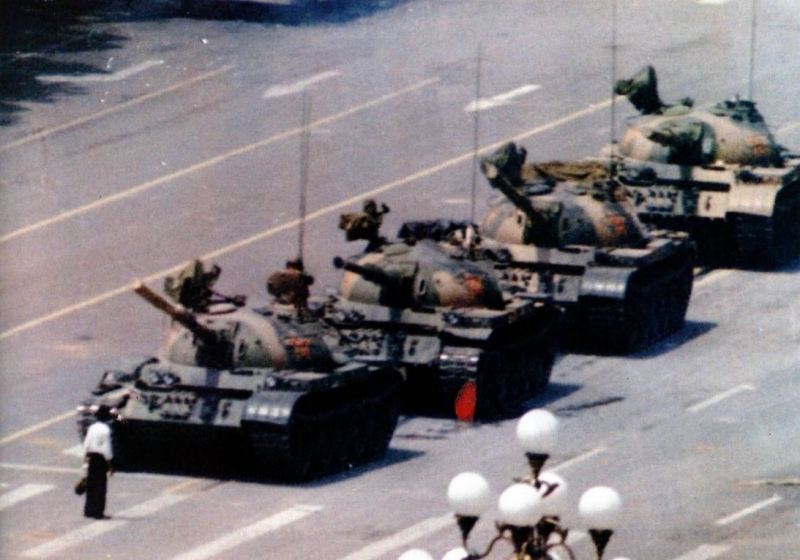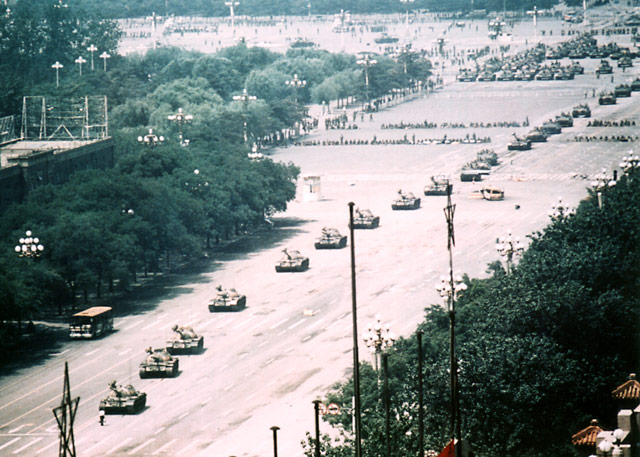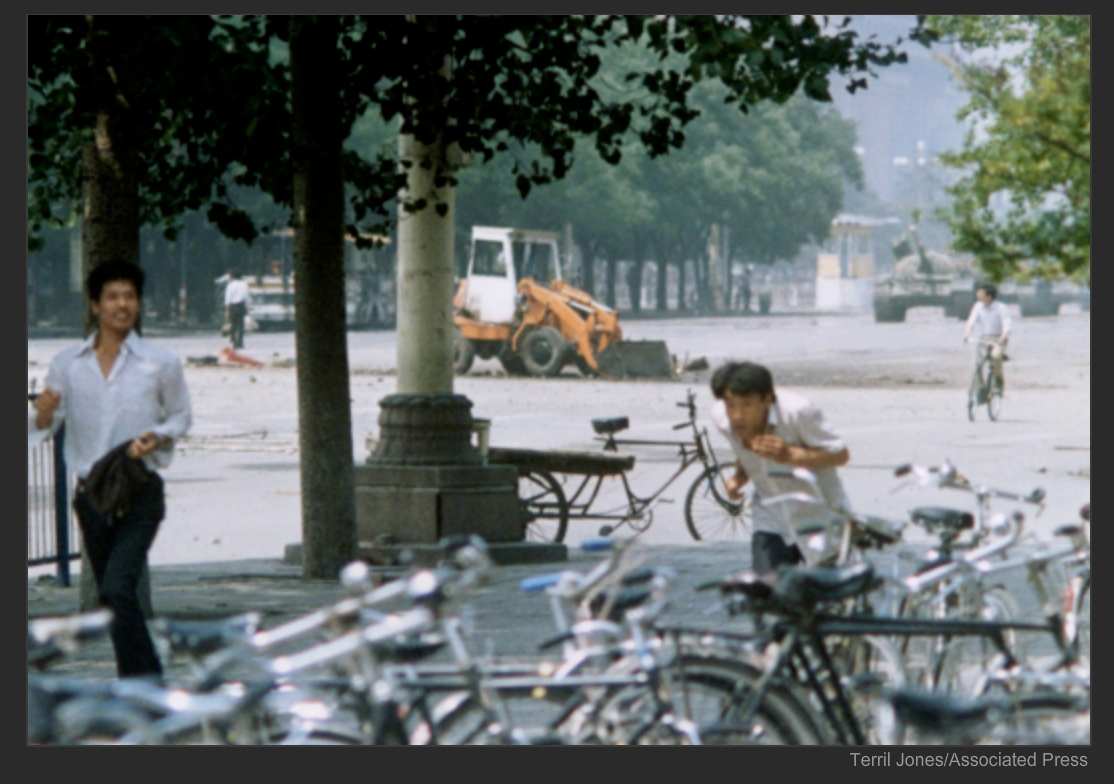Also known as the “Unknown Rebel,” Tank Man is the nameless protagonist of a stand off with a column of Type 59 Chinese tanks. His stance, encapsulated in time on Beijing’s Changan Avenue, is determined. He is slight, wiry in the tradition of a wushu hero perhaps. We’ll never know his face: only the set of his shoulders, and his angry strides.
Tank Man is one of the most iconic images of the 20th century, and of course one of the ones most closely associated with the Tiananmen Square Massacre. All over the Internet I’ve seen people attributing the image to June 4th: as if he stood at the front of the Square while the tanks rolled in. Actually, June 5th is his day. And I think it’s important that we remember the distinction. Why? Because June 5th was the day of bald-faced, daylight violence. It was the morning after tanks and troops rolled through Beijing, clearing the Square and shooting residents in their neighborhoods. It’s important because Tank Man saw all of this and stood up anyway.
It’s important we imagine Tank Man complexly, or as well as we are able to with so little information about who he was and where he lives (or lived) out the rest of his days. Most people know him as a moment in time. Five photographers captured Tank Man, and by far the most widely circulated image comes to us from the AP’s Jeff Widener. It’s the one at the head of this post. It’s the one that accompanies all of these front page stories, once it was smuggled out of China by a young tourist. Shot from the balcony of the Beijing Hotel, it shows us an succinct portrait of what is essentially a civilian man (benign to the point of absurdity: he carries what could almost be shopping bags in his hands) standing against the state machine, here represented by four tanks. Outside the action, artifacts from reality remain. Specifically, there’s a cluster of lamps in the lower frame that draws my eye every time I look at this photo. That mundane street lamp gives this image a greater context: this is not a war zone, it reminds us, this is a street in the very heart of Beijing.
Those unlit lamps draw us back into the day. On June 5th security forces were shooting anyone who approached the Square. Anyone. Including people running away, doctors, nurses, and rescuers. Even those approaching to collect the dead. Those unlit street lamps remind us that we’re in a city, and not even just any city but the one that’s been the capital of China for hundreds of years. As journalist Jan Wong points out, not even Mao had ever dared bring the military into Beijing. But China’s then-leaders didn’t just mobilize local troops, they brought in soldiers from all over the nation—as far away as Guangzhou province. Soldiers were using battlefield-grade weapons on unarmed civilians in the heart of the capital. Those Type 59 tanks the Unknown Rebel faces off against remained the backbone of the Chinese army for over another decade. The situation is ludicrous. Dystopic. A precedent.
Want more context? Here’s the rest of that tank column.
I’ve been seeing many people sharing the zoomed out photo this year. It’s good to compare it to Widener’s commonly seen shot because it adds perspective. You would assume that a column of tanks would be much longer than four, but seeing it laid out for you is quite different. What strikes me is how easy it is to throw a wrench into such a large machine. Because really, you don’t have to stop all of those tanks individually: you only have to stop the tank in front. And how do you stop the tank in front? You stop its commander.
The image of Tank Man has become a symbol. And oftentimes, we forget that what’s symbolic doesn’t necessarily line up with what’s real. There is a symbolic relationship between Tank Man and the column of tanks. Here, so neatly laid out, is the power of the state against the power of the individual. And this is where we draw our most black and white view of him: one person, Tank Man tells us, is enough to stand up against the state. And our empathy, of course, lies with the individual: human and singular versus a literal war machine.
But remember how many people are actually in this photo. A tank is not a drone. There are people inside it. What we see of Tank Man usually is just the one moment. A powerful, powerful moment, but only a moment nonetheless. When we just view the photo, we’re missing out on the interaction. Fortunately, we have more at our disposal.
Tank Man seems to taunt the authority of the state. While the commander of the tank tries to go around him, he steps in front of it again and again before finally climbing onto the tank itself. He actually bangs on the hatch of that first tank and converses angrily with its occupants: probably its commander and its gunner. In the end, he’s led away by a cluster of men, and dissolves back into the crowd. Let’s remember that Tank Man isn’t just a lone rebel for a moment. He converses with soldiers that blazed their way to Tiananmen the night before, part of a group even responsible for shooting people inside their apartments—their kitchens—with battlefield grade weapons. Their story is the full interaction: a conversation we can’t eavesdrop on because their voices have been lost to time.
Why did that leading tank stop? There are reports of disobedience in the military. One general lost his command and was subsequently jailed because he refused to carry out the violence the night of June 3rd without receiving written orders. (Only verbal orders were given that night, because, again paraphrasing Jan Wong, Chinese people have this thing about history: while those in charge write the rules now, the next dynasty never forgets.) But literally on the other side of the Square civilians are getting mowed down, so why is this one guy such a big deal?
There are competing theories here. There were, like that aforementioned general, acts of defiance within the People’s Liberation Army. Soldiers who later claimed they fired into the air rather than at civilians. And there is one theory, given to The Epochtimes by Chinese dissident Wei Jingsheng, that the commander of the tank column had been classmates with Tank Man. This seems like pure speculation, and verifying it is borderline impossible.
I include it because there’s something romantic about it; it captures the imagination. The Fox and the Hound recast in modern China, perhaps? Two boys who grew up together during the hardships of the Cultural Revolution later end up on separate life paths. One joins the PLA, the other settles in Beijing. Both experience the most horrific nights of their lives and only one of them is trained to deal with it. Then, their paths cross one last time at the Gate of Heavenly Peace. The telescopic lenses of the world watch from the windows of the Beijing Hotel. There isn’t a dry eye in the audience.
It’s a cinematic narrative, and, like all things of such a nature, we want the Hollywood ending. But there isn’t one. A group of men talk to our Unknown Rebel before he gets hustled off. Are they security forces? Do they mean him well? Again, no one knows. Some like to believe that they were benevolent bystanders, and that somewhere now Tank Man is going about his daily life: anonymous, still in China. Maybe without even knowing he has become an international symbol of resistance.
But Wei’s narrative ends rather badly. He says the gentlemen who hustled our hero away were in fact plain clothes security officers who were in fact trying to keep Tank Man safe. Unfortunately, they lost track of him and he rushed in front of another column of tanks, the commander of which our hero hadn’t been schoolboys with. He was crushed to death, out of sight.
In other theories he fares no better: perhaps he was executed immediately after events, perhaps he withered in jail first.
Regardless, neither his death nor his well-being have ever been confirmed. So let’s end the series with a prequel instead. In 2009 Terril Jones of the Associated Press shared a gem of a photograph with the New York Times. It offers new angle on the Tank Man: street level, before the action.
The action in this photo is in the foreground: we first look at the men running away. But then our eyes are drawn away by stillness, and in the back left corner we see him. A tiny David, sizing up his Goliath. Recognizable from the set of his shoulders, we will still never know his face. There is ambiguity in his stance: is he on the edge of a premeditated leap? Or are we looking at the moment of calm right before a heroic impulse? Again, it’s almost impossible to know. But let’s linger over him a moment more before he walks into history, and out of our sight.





Reblogged this on OVV.
Your style is so unique in comparison to
other folks I’ve read stuff from. Many thanks for posting when you’ve got the opportunity, Guess
I will just book mark this web site.